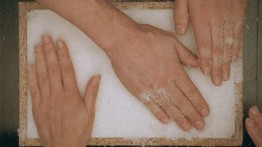THE CRUDE AND THE RARE
Tue, Oct 19, 2010 12am - Sat, Nov 20, 2010 12am
THE CRUDE AND THE RARE
OCTOBER 19 - NOVEMBER 20, 2010
Marina Abramović // Terry Adkins & Blanche Bruce // Bik Van der Pol // Ursula Biemann // Lonnie van Brummelen & Siebren de Haan // Mark Dion // Jimmie Durham // Grady Gerbracht // Alfredo Jaar // Sara Jordenö // Robert Kinmont // Jeff Lovett // Lize Mogel // Margaret Morton // Matt Mullican // Sophie Ristelhueber // Austin Shull // Lawrence Weiner // Gilberto Zorio
The Crude and the Rare, a group exhibition curated by Saskia Bos and Steven Lam, explores the intersection of materiality and resource extraction in contemporary art. The exhibition includes newly commissioned projects and work made in the past few decades, some of which have never been exhibited in New York City.
With a diverse group of artists that spans multiple generations and geographic areas, the exhibition investigates the political economy of precious substances such as gold, diamonds, oil, and other natural resources. In their raw and unrefined state these substances evoke curiosity and desire through their sheer surface, color, density, and luminosity. But when harvested and transformed, materials once seen as natural acquire value not only as exchange value, but their symbolic value deepens our understanding of them.
Historically, the industrialization of natural resources resulted in numerous environmental and geopolitical conflicts. In recent times, these extractive industries, which are often geographically removed from the world’s major financial centers, not only include the workers that produce them, but their value is also controlled by governmental entities and private investors.
The Crude and the Rare responds to this context, featuring an international roster of artists interested in the raw materiality of precious substances as well as in how these materials create and determine social relations. How has matter inspired creative process or become the subject of critical investigations, specifically in a moment in which dematerialization and connectivity are favored over tactility and presence? How can artistic labor respond to the complicated and sometimes imperceptible changes that occur in spatial territories marked by political or economic instability?
References to the spiritual and to the political pervade the history of contemporary art. It is this coming into-being, the alchemical poesis of making, in which touch, physicality, and the transformation of matter are crucial elements for this exhibition. In metaphorical or concrete ways, artists have both commented on the material world, and on the world of materials, “materia prima,” the transcendence of which will always lie in the eyes of the beholder.
This project was funded in part by generous support from David Zwirner, the Cultural Services of the French Embassy in the United States, and The Cooper Union Institute for Sustainable Design.
OPENING RECEPTION
Tuesday, October 19, 6 - 9pm
41 Cooper Gallery, 41 Cooper Square
PANEL DISCUSSION
Tuesday, October 28, 6 - 8pm
The Great Hall, 7 East 7th Street
Open daily Tuesday - Saturday, 11am - 6pm. Closed Sunday & Monday.
Located in the 41 Cooper Gallery, located in 41 Cooper Square, on Third Avenue between 6th and 7th Streets.






